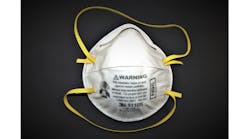The Centers for Disease Control and Prevention (CDC) has updated its guidance documents aimed primarily at healthcare industry employers in regard to N95 masks, ending changes it had made during the period when the masks were in short supply last year.
Last year, the CDC worked with the National Institute for Occupational Safety and Health (NIOSH) to allow usage of some kinds of masks exceeding the manufacturer-designated shelf life in times of increased demand and decreased supply, so long as appropriate storage practices were followed.
In addition, the CDC released a strategic document that deals with appropriate use of respirators when they are available at various types of “surge” capacities (that is, conventional capacity, contingency capacity and crisis capacity).
“The updated CDC guidance acknowledges that the availability of NIOSH-approved respirators has increased significantly in recent months,” say attorneys Sarah M. Martin and Bradford Hammock of the Littler Mendelson law firm. “In light of this increased supply, the updated guidance adds new strategies for conventional capacity and removes previously applicable strategies for crisis capacity respirator availability.”
The CDC said its assumption was that “once personal protective equipment (PPE) supplies and availability return to normal, healthcare facilities should promptly resume conventional practices. The supply and availability of NIOSH-approved respirators have increased significantly over the last several months.”
The attorneys point out that the Occupational Safety and Health Administration (OSHA) regulations detailing its Respiratory Protection standard require employers to provide appropriate respiratory protection, such as N95 respirators, when necessary to protect employees from a known hazard in the workplace.
The use of a respirator, in turn, also requires “proper training, fit testing, availability of appropriate medical evaluations and monitoring, cleaning, and oversight by a knowledgeable staff member,” according to OSHA. Employers should check the NIOSH Certified Equipment List to identify all NIOSH approved respirators and approval holders.
In light of this increased supply of N95 masks, the CDC’s updated guidance adds new strategies for conventional capacity and removes previously applicable strategies identified for the different periods of respirator availability. It also addresses changes in how to deal with contingency capacity, which occurs during periods of expected N95 respirator shortages.
The CDC recommendations also include crisis capacity strategies where standards are not commensurate with U.S. standards of care but may need to be considered during periods of known N95 respirator shortages. Crisis capacity strategies should be implemented only after considering and implementing conventional and contingency capacity strategies, the CDC argues.
Martin and Hammock note that some of the major changes include:
• Non-NIOSH approved respirators developed by manufacturers that are not NIOSH-approval holders should not be used, even at crisis capacity.
• Decontamination of respirators for limited reuse is no longer an approved strategy, even at crisis capacity.
• At crisis capacity, reuse of respirators should be limited to no more than five donnings per device by the same healthcare provider (HCP).
• At crisis capacity, face masks should only be used as a last resort when caring for a patient that is suspected or known to be infected with COVID-19.
• At contingency capacity, respirators should be prioritized for HCPs using the respirators as PPE over those who are using the respirators as source control.
• At contingency capacity, N95 respirators used for an extended time as PPE should be discarded immediately after their removal.
When it comes to conventional capacity strategies, the CDC added language on extended use of N95 respirators as source control and regarding use of respirators with exhalation valves. These include engineering controls that reduce exposures for HCPs by placing a barrier between the hazard and the HCP, which could be a plexiglass shield or curtain.
“Engineering controls can be very effective as part of a suite of strategies to protect HCPs without placing primary responsibility of implementation on them (i.e., they function without the HCP having to take an action),” the CDC says.
When the supply of respirators has run out completely, the CDC says it is time for employers to consider taking more drastic measures by excluding HCPs who may be at increased risk for severe illness from COVID-19 infection—such as from those of older age, those with chronic medical conditions, or those who may be pregnant—from caring for patients with confirmed or suspected COVID-19.
Martin and Hammock recommend that employers who provide respirators should review their practices for compliance with the updated CDC guidance at the appropriate capacity level.

